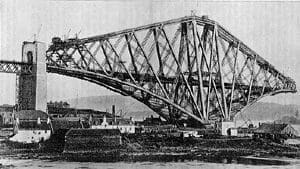
This structural form illustrates the outstanding application of iron and steel to bridge construction. Cantilevers were one of the first bridge types, many being built by the ancient cultures of China and India. The first modern cantilever was Heinrich Gerber’s Hassfurt Bridge over the Main in Germany (1867), with a central span of 124ft (38m). It was a continuous girder hinged at the points of equal resistance where the moments of the uniform load were zero. By inserting hinges, the continuous girder was made statically determinant. Later on the possibility of erection without scaffolding was recognized – the ability of the arms of the bridge to be built out from the piers, balancing each other without the need for falsework or scaffolding. This became the great advantage. The principle also is applicable to other bridge types.
Forth Bridge (1890)
The world’s most famous cantilever also is one of the world’s first and largest steel bridges and held the record for longest cantilever for 27 years: The Forth Bridge. To ensure that there was no repeat of the Tay disaster, a series of tests were conducted, gauging wind at several sites in the area over a two-year period, arriving at a design pressure of 56lb/ft2 (274kg/m2), which was considerably in excess of any load the bridge would ever sustain. Each of the two main spans of the bridge consists of two 680ft (207m) cantilevers with a 350ft (107m) suspended span for a total length of 1,710ft (521m). John Fowler and Benjamin Baker designed the Forth Bridge (1890) to resist wind loads 5.5 times those that toppled the Tay Bridge.
The Forth Bridge’s record was broken in 1917 when the Québec Bridge was finally completed, spanning the St Lawrence River near Québec (Canada) with an 1800ft (549m) cantilever span.
The largest cantilever in Europe was Saligney’s Danube Bridge near Czernavoda (Romania), with a span of 623ft (190m). Another great cantilever is the Howrah Bridge over the Hooghly River at Calcutta (India), with a span of 1500ft (457m).

Be the first to comment